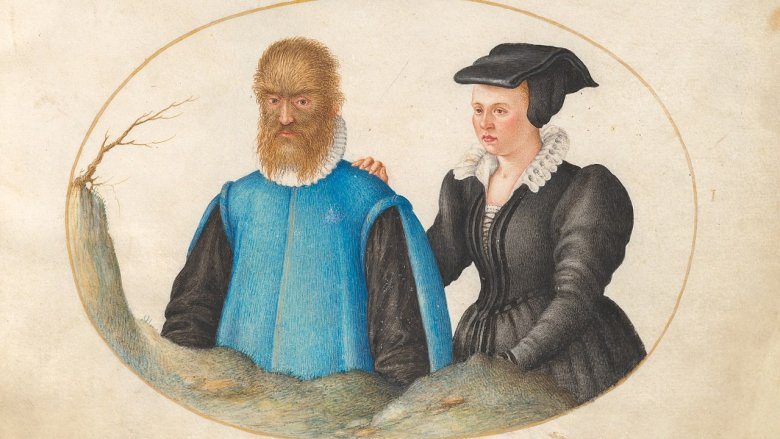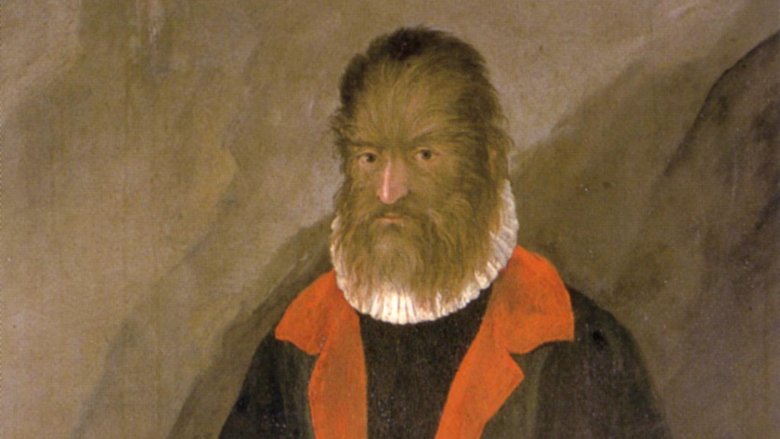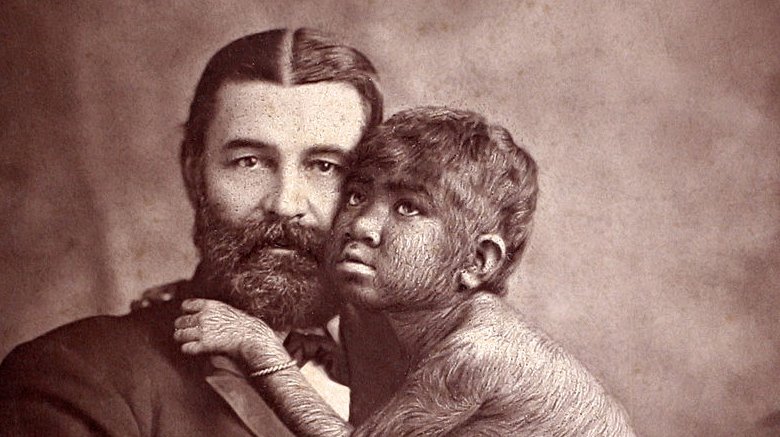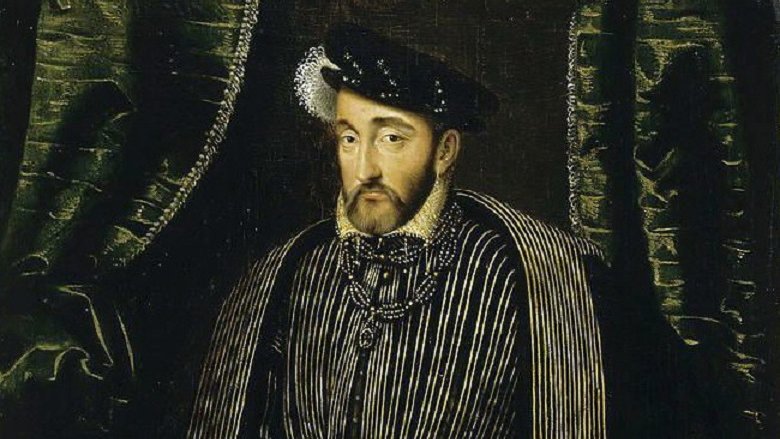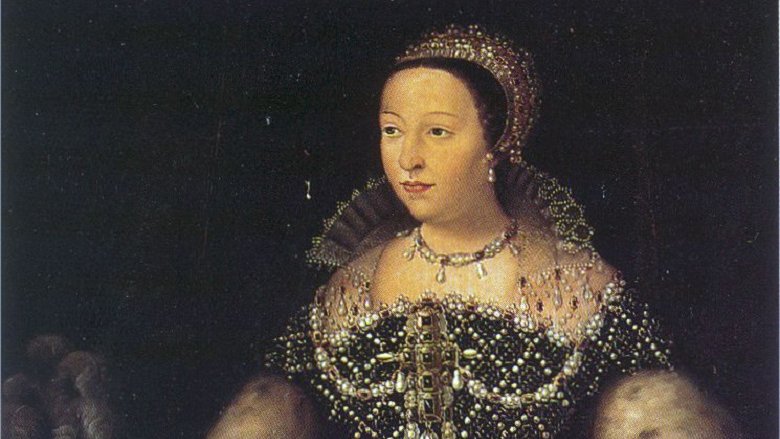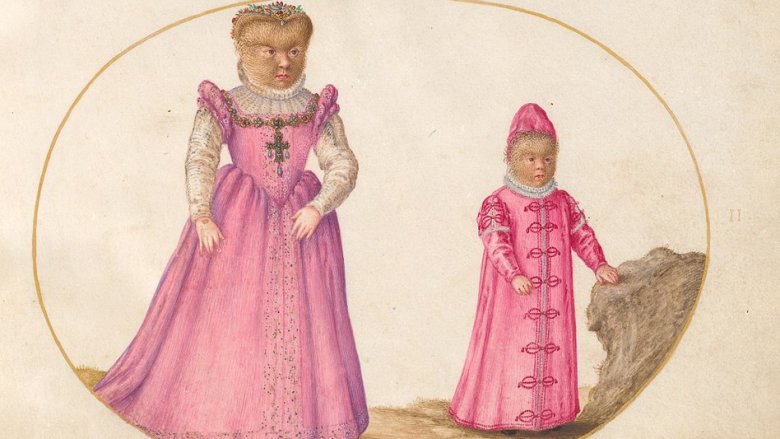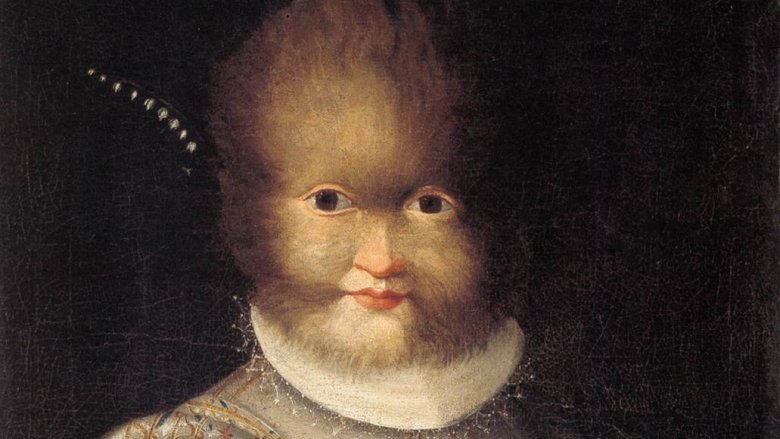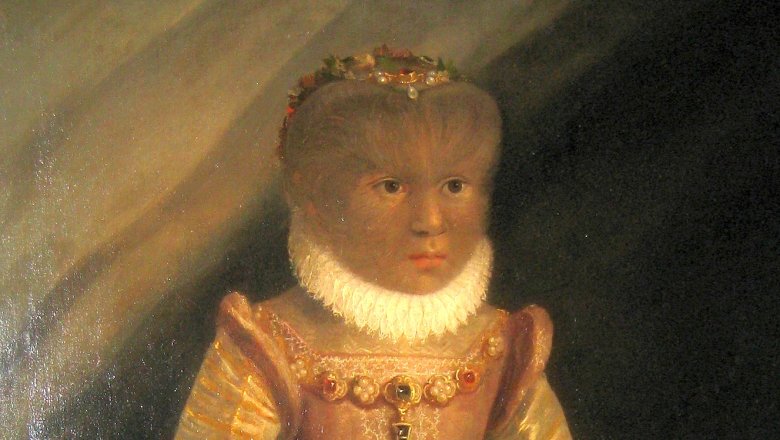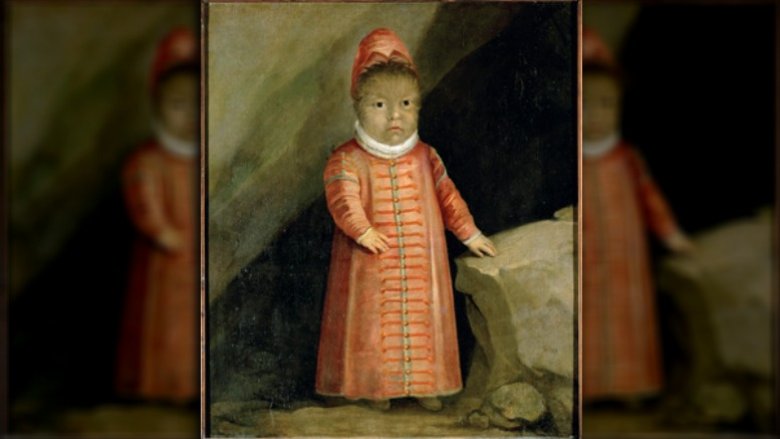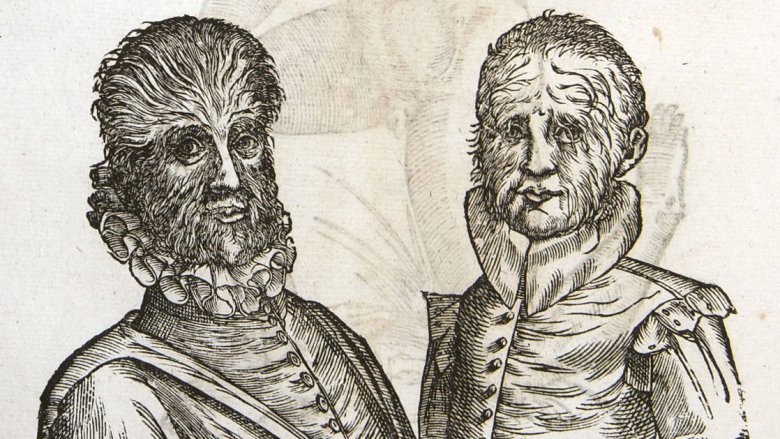Beauty & The Beast's Inspiration Was Too Dark For Disney
Everyone loves the story of Beauty and the Beast. There's something romantic about a woman looking beyond a terrifying appearance to see the good person inside. The Disney version of Beauty and the Beast was so good it managed to become to the first full-length animated feature film in cinema history to be nominated for the Academy Award for Best Picture. Sure, there's the kidnapping aspect that's a bit problematic, and the Beast does have quite the temper, but if you ignore all that it's a beautiful love story.
While there have been tales of women and wild men for ages, the story we know best today was written in France in the 1700s. And there is some evidence it was based on the real-life relationship between Petrus and Catherine Gonsalvus. In the 1500s, the beautiful Catherine and the beastly, hairy Petrus married, but the real "Beauty and the Beast" story is so much more complicated than any fairy tale.
The beast was kidnapped as a child
Pedro Gonzales was born in Tenerife in 1537. According to Portraits of Human Monsters in the Renaissance, Spain conquered the Canary Islands in 1495. Many of the native people, the Guanches, were forced into slavery. When Pedro was born completely covered in hair, he was probably shunned and eventually abandoned. Still, someone must have taken care of him at least for a while because he survived childhood.
When Pedro was 10, the Venetian ambassador to Spain gave the boy to the new king of France, Henri II, as a present. While it might seem weird to give a hairy human as a gift, Pedro's people had been enslaved and having humans at court that were slightly different, like a dwarf as a jester, was considered very cool. Owning the hirsute child made Henri look good.
That doesn't mean Pedro's new life started out all that great. Ranker records that because his hair made him look like a "wild man" from legends, he was considered little more than an animal. It didn't help that he couldn't speak "any comprehensible language." The Smithsonian says the child was put in a cage and fed raw meat and animal feed. The king's doctors examined Pedro to see just how wild he was. But the boy was just a calm (and, History Collection notes, probably terrified) child. He managed to whisper his name, but it was far too Spanish for his new home, so the king changed it to the fancy Latin version, Petrus Gonsalvus.
Ambras syndrome is unbelievably rare
In the genetic lottery, Petrus was extremely unlucky. He suffered from a kind of hypertrichosis, the most extreme form, where thick, soft hair covers every part of the body except the palms, soles of the feet, and mucous membranes, according to the Genetic and Rare Diseases Information Center. Sometimes called "werewolf syndrome," its real name is Ambras syndrome. PLOS reports this was indirectly because of Petrus. A famous portrait of his family hung in Ambras castle, so they became known as the "family of Ambras," which led to the Ambras name being attached when the genetic abnormality was finally pinpointed in 1993.
Whatever you call the syndrome, it's unbelievably rare. Thought to affect fewer than one in a billion people, there have only been about 50 to 100 cases recorded since the Middle Ages. Any time a hairy person is born, it becomes a big deal. Some, like Petrus, found homes at royal courts. Shwe-Maong of Burma became a royal favorite in the 1800s. But eventually, many of the extremely hirsute ended up in circus sideshows under the guise of "dog-faced men" or "bearded ladies."
While Petrus may originally have been locked in a cage, and circus freaks were gawked at for entertainment, modern individuals aren't any better when faced with someone with Ambras syndrome. In 2011, 12-year-old Supatra Sasuphan was named "world's hairiest girl" by the Guinness Book of World Records, which she noted was a step up from what she was usually called by people: "wolf girl" and "monkey face."
Things finally started looking up for Petrus thanks to Henri II
While Petrus also ended up in slavery, just like many natives of the Canaries, the fact he was a "freak" might have saved his life. He wasn't seen as a normal slave, but as a precious commodity that bestowed honor on his owner. So Henri had a vested interest in keeping him alive and well. Hushed Up History says that once it turned out the wild boy wasn't wild at all, Henri decided to try an experiment.
According to History Collection, the king took Petrus out of the cage, gave him the finest clothes, and started teaching him the same things noblemen of the time learned. The boy's fancy education included military training, etiquette, speech, reading, and writing. He turned out to be exceptionally intelligent, becoming fluent in three languages, including Latin, something Portraits of Human Monsters in the Renaissance observes made him unusual even among French courtiers. The wild man no one thought could be trained ended up being a prodigy, and Human Marvels says he became a sought-after guest at court, with royal dignitaries and ambassadors flocking to meet him.
The fact Petrus was so smart and everyone liked him made King Henri look really good. Petrus attended court like other gentlemen and rose through the ranks until he eventually held a place of honor among the king's attendants. But nothing changed the fact he was covered in hair. His appearance always set him apart as different, and he would never really be an equal at court.
Catherine de' Medici decided to mess with Petrus
As long as Henri was on the throne, Petrus had a royal patron. His protection and position were assured since the king liked him. So it was a major bummer for Petrus when King Henri suddenly died.
Henri did not have a nice end. According to History Today, in June 1559, France and Spain signed a peace treaty and the king threw a big jousting tournament to celebrate. Henri's wife, Catherine de' Medici, tried to talk him out of participating, but he insisted. The king did well, until the Count of Montgomery almost unseated him. Everyone told Henri to just let it go, but since losing made him look bad, he insisted on a rematch. This time things went a lot worse. The count's lance hit the king's helmet, and part of it went through Henri's eye and into his brain. The king lingered for over a week before dying of sepsis, age 40.
Since Henri's oldest son was only 15, Queen Catherine was basically in charge of France until he grew up. Catherine was not a nice person. Her idea of celebrating one of her daughter's marriages was to order the murder of a bunch of Protestants. Like her husband before her, Catherine also decided to try an experiment with Petrus. Hushed Up History says she realized that if one hairy man was valuable to the court, owning more hirsute people would be even better. She wanted Petrus to have children; hopefully they would turn out hairy.
His bride was in for a shock
Considering the values at the time, even a hairy man who was not considered quite equal to a normal man needed to be married to have children. That meant Queen Catherine had to find him a wife. Fortunately, her position meant she had the power to arrange marriages for people at court without taking their feelings into account. History Collection says she enjoyed playing matchmaker, and with Petrus even more so. The dowager queen interviewed "at least a dozen girls" for the job of the hairy man's mate.
According to Hushed Up History, the queen finally settled on the daughter of a servant, also named Catherine. The maiden was allegedly chosen because she was extremely beautiful, and Queen Catherine wanted to see what happened when a hottie married a wild man. While Refinery 29 reports the queen also picked Catherine because she wanted a woman who wouldn't be scared of someone so different (they would have to make babies, after all), the girl wasn't told who she was marrying and therefore had no idea what to expect. Catherine didn't have the right to refuse the queen's arranged marriage, but coming from such a lowly background, she probably thought being selected to marry a nobleman was a stroke of luck. It was only at the altar on her wedding day that Catherine found out what she was in for.
Unfortunately for history, Ranker says Catherine's initial reaction to her husband wasn't recorded, although there were rumors she wasn't happy with the situation.
Their hairy kids were taken away from the couple
Still, Catherine must not have been that disgusted by her new husband because about a year after their wedding she gave birth to their first child, according to Hushed Up History. Unfortunately for the queen, the baby had a regular amount of hair. She probably got really frustrated when the couple's second kid was also born looking typical. But then baby number three was just as hirsute as the father. Catherine and Petrus would have seven children in all, with four of them covered in hair.
But like their father, the hairy children were considered less than human and basically slaves. While History Collection notes that the kids were raised as nobles, living a life of luxury most children of low birth could never expect, with high-quality education, plenty of food, expensive clothes, the best doctors, and beautiful homes, they were not free. Queen Catherine had made their parents marry essentially in order to breed fancy pets. Now she had four of them.
Over time, the hairy children were given away to other courts in Europe as presents. Francesca, Antoinetta, Madelina, and Enrico were all treated well in their new homes, but they were far from free. The three children that took after their mother may have gotten to stay with their parents, but people were entirely uninterested in them. Ranker says the non-hairy kids weren't even allowed to be in family portraits, and there are no images of them today.
They had to make their own way in the world
Catherine de' Medici, like Henri II, was a useful patron for Petrus, even if her experiment with him was meant to be crueler than her husband's. But while the queen was alive, he and his family had a place to live and a guaranteed income. Petrus might have been seen as a freak, but he was safe and held an exalted position at court. When Queen Catherine died in 1589, the family suddenly had to make their own way in the world.
According to Portraits of Human Monsters in the Renaissance, the hairy family had to lean into their abnormality in order to be "shown, adopted, or accepted" at courts outside France because it was their "only means of survival." After Queen Catherine's death, there are records of the family traveling to places like Bologna, Parma, Ferrara, and Rome. They would eventually find homes at other courts where they were paid "very well," although, as Curiosity points out, this was because the hairy family members were seen as a form of fun and were really being "exploited for their entertainment value." Some of the hairy kids were given away in this period, possibly a choice by their parents, and if it was it would be to ensure they had safety and a guaranteed future.
All the traveling and the splitting up of the family meant lots more people heard about them. Hushed Up History says that eventually the members of the Gonsalvus family became some of the most famous individuals in Europe.
The hairy family members were seen as animals
Despite their lifestyle and the fact they rubbed shoulders with royalty, the Gonsalvus family, the hairy members at least, were still in a weird limbo. According to one historian, they were "neither captured nor free." It didn't matter how nice, polite, intelligent, or popular they were — because they were covered in hair, they were never going to be seen as fully human. At best, they would be considered wild or savage people, at worst, actual animals.
Shakespearean Maternities says the hirsute Gonsalvuses were popularly known as "cat people." The article "The Wild and Hairy Gonzales Family" records other times they were compared to animals, with people saying they had hair "like the fur of a sable," skin "similar to that of an unfledged bird," and that Petrus was "not less hairy than a dog." While there is evidence some did see the family just as unfortunately hairy humans, those people seem to have been few and far between.
It didn't help that the Gonsalvus family lived at a time when stories of wild men were widespread and had very specific moral meanings behind them. While the Beauty and the Beast story popular today wasn't written until 1740, there were already plenty of tales about women getting it on with animals, voluntarily or not. Laws about such unnatural relations became more stringent, and the idea arose that wild men, an animal/human hybrid, were the result of such cross-species meetups. Petrus and his hairy children were therefore evidence of "abominable" acts.
Society was weirdly obsessed with them
While the non-hairy children weren't allowed in family portraits, people could not get enough of pictures of the hirsute ones. According to Portraits of Human Monsters in the Renaissance, if you didn't live at a court where you could see them all the time, having a portrait of a member of the Gonsalvus family became a must. That's why there are a surprising number of paintings and drawings of the hairy family members, because there was a creepy obsession with them.
Paying for a portrait was not cheap, but Hushed Up History said nobles would shell out then give the pictures away to their friends as special presents. The family is always pictured wearing extremely luxurious clothes, which just sets off their hairy faces. But there were rich people who wouldn't settle for a picture, no matter how beautiful or lifelike, and bought one of the children instead.
Scientists were just as fascinated with the family as nobles were. Over time, the hairy Gonsalvuses were studied and written about at length. However, in general, the learned men were more understanding of the hairiness. History Collection reports the famous naturalist Ulisse Aldrovandi sketched and took notes about Antoinetta, and he referred to her as a "girl" rather than some kind of animal. Anatomist Felix Plater was even more understanding, pointing out in his study of the Gonsalvus children that all humans have hair in every pore, that excess hair could happen to anybody, and that plenty of men are quite shaggy.
We don't know what happened to the family
Despite all the things we know about Petrus' early life and what happened to his family after they left France, eventually they disappear from the historical record. History vs. Hollywood reports that after traveling around Europe for years, the remaining family members settled in Parma, Italy, where they were employed/owned by Duke Ranuccio Farnese. According to Hushed Up History, Petrus was put in charge of an estate in the village of Capodimonte, where he maintained the lands and vineyards.
After that, there are only hints about what happened to the family members. The Human Marvels says it's believed at least one of the hairy Gonsalvus daughters married and had her own children. There is evidence Catherine died in 1623. The last mention of Petrus is in 1617, when he attended the christening of one of his grandchildren. There is no record of his death. Sadly, this might be because he was considered too wild and animal-like to qualify for a Christian burial. The graves of Catherine and Petrus have never been found.
While they were married an estimated 40 years and had seven children, people still wonder if Catherine and Petrus were actually in love. One hint they were is in a portrait of the couple, where she has her hand on his shoulder. History Collection notes this was a gesture that was used by painters to show genuine affection between husbands and wives, so it's possible their relationship was a worthy basis for Beauty and the Beast.
